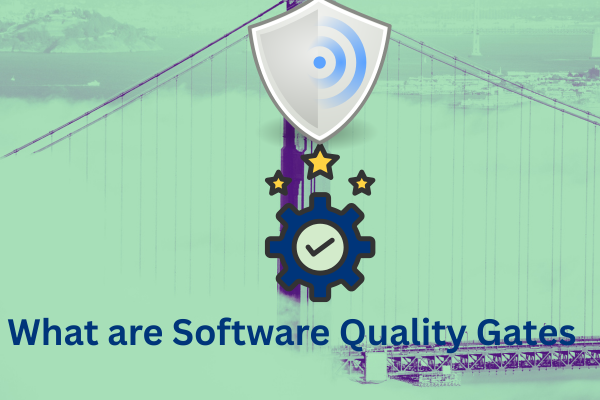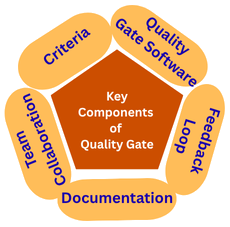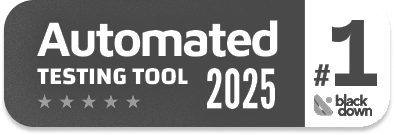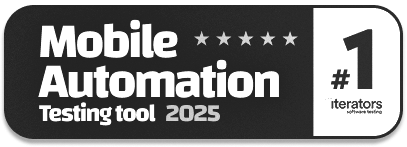Software Quality Gates: What They Are & Why They Matter
|
|
Speed and quality are often at loggerheads with each other when one is trying to develop software, but also ensure it meets the customer’s timelines. This means that quite often, you’ll find yourself randomly checking different aspects of the software and then deeming it as ‘ready’. But this can prove to be a risky strategy. Hence, systematic software quality gates are the best way to ensure that every stage of the software delivery pipeline maintains consistent quality standards. Let’s learn more about these quality gates in software development and testing.
| Key Takeaways: |
|---|
|
This article explores the concept, importance, implementation, and best practices for using software quality gates effectively.
Introduction to Software Quality Gates
A software quality gate (aka quality gate) is an automated checkpoint in the SDLC that evaluates if a code meets a predefined set of criteria before it can proceed to the next phase of the development pipeline, such as from development to testing, or from testing to production.

Software quality gates serve as decision points that can automatically block code with issues/defects, ensuring a higher-quality product and preventing problems from progressing to later phases. In other words, the software quality gate acts as a decision-making barrier that performs the following actions:
- If the software meets all the conditions or criteria, it “passes” the gate and moves forward.
- If it does not meet the criteria, the process stops until the issues are resolved.
You can think of a quality gate as a quality assurance checkpoint integrated into your Continuous Integration (CI) or Continuous Delivery (CD) pipeline. These gates enforce organizational standards and automatically prevent poor-quality software from advancing. They help foster consistency and confidence throughout the entire SDLC.
- The software quality gate checks various criteria, including code coverage, complexity, and security vulnerabilities. They also maintain code complexity standards. Read: Entry and Exit Criteria
- They can be tailored to specific project requirements. For example, a project with critical security requirements might have a quality gate focusing on identifying potential security risks.
- Quality gate software often automates these checks, making the process more efficient and reliable.
- Quality gate software can be integrated with other development tools to provide a seamless quality assurance process.
- Quality gates play a crucial role in maintaining product reliability and customer satisfaction.
- They help catch issues early and reduce the cost of quality.
- Software quality gates also serve as a communication tool among cross-functional teams.
- They also facilitate better decision-making and coordination by providing clear visibility into a project’s quality status.
- Quality gates are typically located before SDLC phases that are highly dependent on the outcome of a previous phase, where potential trouble spots need to be addressed and resolved.
- The concept of software quality gates combines aspects of decision modelling, workflow management, and project management to enhance measurability and promote superior conditions for software development.
- Quality gates can be applied at various levels throughout an organization, including system, project, and release levels. They can also be used as part of overall product development and quality assurance (QA) methodologies.
Example of a Software Quality Gate
- Code coverage must be ≥ 75%.
- No critical or high-severity vulnerabilities.
- All unit tests must pass.
- Performance metrics (response time, CPU usage) are within acceptable thresholds.
If any of these conditions fail, the gate blocks deployment, ensuring only high-quality builds progress to deployment.
Key Components of a Quality Gate
Software quality gates consist of several key components that work together to ensure the software meets the required standards. The key elements of a quality gate are:

Criteria
The first key component of quality gate is the criteria. These are the standards or conditions that the software must meet to pass the quality gate. Standard criteria for SDLC include code coverage, complexity, test results, performance, security vulnerabilities, and compliance.
Quality Gate Software
This is the second component of the software quality gate. It automates the quality checks, ensuring that they are consistently applied at the designated points.
Feedback Loop
The feedback helps developer teams understand what needs improvement and what has failed. When the software being checked does not pass the criteria, the quality gate software provides feedback to the developer team, reporting the problems found.
Documentation
The next key component of the software quality gate is the documentation. The documentation component includes the criteria, the results of the quality checks, and the feedback. It provides a detailed record of the quality gate process. Read: Test Documentation: Best Practices with Examples
Team Collaboration
Team collaboration is the final component in the software quality gate process. It emphasizes teamwork as the team must understand the quality gate process and be committed to maintaining high standards.
How Does a Quality Gate Work?
Quality gates ensure that a project is well thought out technically and can be supported after deployment. They contain predefined conditions based on aspects of the project that can be measured. With these conditions, the project undergoes a phase-by-phase checklist, and project managers communicate the process continuously, reducing the development cycle time and achieving a well-designed product.
- Pass: All gate metrics are met, and production can continue.
- Warning: Gate metrics may not be met, or may be met only just barely, and should be verified before production continues.
- Fail: Gate metrics are not met, and issues must be resolved before production can proceed.
Monitoring the quality of project results by setting preset benchmarks and steering a project at key points can help resolve these issues.
The Purpose and Benefits of Quality Gates
- Ensuring Consistent Quality: Quality gates are vital in ensuring consistent quality and reliability of the product. They help maintain high-quality coding standards throughout the SDLC, prevent defects from slipping through the cracks, and reduce human bias and errors. By actively tracking metrics such as error rate, success rate, and CPU load, quality gates foster confidence in teams during software releases.
- Reducing Technical Debt: With quality gates, teams avoid accumulating technical debt by catching issues early, before deployment or release. Well-defined quality gates at regular checkpoints prevent the escalation of problems as software advances through the pipeline. Early identification and resolution of potential issues conserves resources and mitigates the need for expensive fixes at later stages of SDLC.
- Enhancing Security and Compliance: Quality gates ensure that software strictly adheres to security and compliance requirements such as OWASP standards, HIPAA, or GDPR. Security checks, such as dependency scanning or static analysis, can automatically block unsafe releases.
- Improving Development Efficiency: Quality gates accelerate delivery over time, although they initially appear to slow development. They prevent low-quality code from advancing, allowing teams to spend less time fixing bugs and more time on innovation.
- Enabling Data-Driven Decisions: Quality gates provide detailed reports on the health of a build containing quantifiable metrics such as test coverage, code complexity, and vulnerability counts. This allows for better decision-making before releases.
- Continuous, Informed Improvement: Quality gates provide continuous feedback on key metrics that empower teams to proactively address issues, encouraging continuous learning from the outset of the SDLC.
Common Quality Gate Criteria
Quality gates are customized based on organizational goals, project type, or compliance requirements. However, several criteria or conditions that are widely used across industries are listed here:

Code Quality Metrics
- Code Coverage: The minimum percentage of code covered by automated tests.
- Cyclomatic Complexity: A measure of the complexity of code logic.
- Duplication: Detecting repeated code segments that appear in code.
- Maintainability Index: Evaluating the ease of code maintenance and extension.
- Bugs and Smells: Limits for the number of bugs, security hotspots, or “code smells” detected by static analysis.
Test Results
- Test Pass Rate: A strict requirement for all unit, integration, or end-to-end tests to pass, or a flexible percentage limit for acceptable failures.
- Test Coverage: Minimum coverage thresholds of code covered by tests.
Security Checks
- Known vulnerabilities in code or dependencies.
- Insecure coding practices or code not adhering to specific security standards or best practices.
- Misconfigurations or hardcoded credentials.
Performance and Load Metrics
- API response times or other execution performance benchmarks are below a threshold.
- Memory usage, CPU, or other resource consumption is within acceptable limits.
- No degradation compared to previous builds.
Compliance and Governance
- Code documentation checks.
- Regulatory compliance scans.
- Licensing verifications for open-source components.
Code Review and Approval
There might exist a human-based quality gate, for example, peer code review approvals. Although not automated, they are still integral to the overall QA framework.
Other criteria
- Build Validation: verifying that the build is successful and all dependencies are resolved in CI/CD pipelines.
- Requirements Traceability: A matrix showing that there are test cases for all requirements.
- Manual Reviews: Conditions to be met during manual code reviews.
Quality Gates in Software Development (SDLC)
- Requirements: Quality gates at this stage ensure that requirements are clear, feasible, and aligned with business requirements, including stakeholder validation and traceability checks.
- Design: In this stage, quality gates verify that the design and architecture meet predefined standards, including feasibility analysis and design reviews.
- Development: In this stage, quality gates verify the code itself by including code reviews, static code analysis, linting, formatting tests, and unit test execution.
- Integration: In the integration stage, quality gates validate code coverage, scan for vulnerabilities in dependencies, and also verify merging and building of the integrated product.
- Testing: In the testing stage, quality gates ensure that critical test cases pass and the number of identified issues is within an acceptable limit. Automated testing, including functional and regression testing, is also verified along with performance or load testing benchmarks.
- Deployment: Quality gates validate deployment readiness at the deployment stage to ensure the software can be deployed successfully. Quality gates also verify the software’s configuration and infrastructure. Smoke testing is also verified in preproduction environments.
- Post-Deployment: A quality gate can also be placed in the post-deployment stage after the release to monitor operational quality, including application performance monitoring (APM), error rate thresholds, and SLA compliance metrics.
Tools Used for Implementing Quality Gates
There are various tools available to automate and enforce quality gates in the CI/CD process. Some of these are listed in the following table:
| Tools | Usage as Quality Gate |
|---|---|
| testRigor | testRigor focuses on end-to-end testing automation, enabling non-technical users to create functional tests in plain English. testRigor can integrate with CI/CD pipelines to act as a functional quality gate, automatically preventing releases that fail critical user journey tests. |
| SonarQube | This is the most popular choice, analyzing code quality, detecting bugs, vulnerabilities, and code smells, and enforcing gates based on configurable metrics. |
| Jenkins Quality Gates Plugin | Jenkins integrates easily with tools like SonarQube or custom scripts to block builds that fail to meet quality gate criteria. |
| Azure DevOps Quality Gates | Azure Pipelines include quality gates for build policies, test results, and code coverage before merging pull requests. |
| GitHub Actions & GitLab CI | These CI platforms enable defining quality thresholds in YAML pipelines, such as requiring zero failed tests or setting security scanning conditions. |
| Other Tools, such as Snyk, JUnit, Pytest, Prometheus, Grafana, and the OWASP dependency checker, also utilize quality gates. |
Snyk / OWASP Dependency Check: Used for vulnerability scanning.
JUnit/Pytest: Use automated testing metrics to verify that all tests are passing.
Prometheus/Grafana: These tools utilize operational monitoring gates.
|
How to Implement Quality Gates?
Implementing quality gates involves both technical setup and organizational alignment. Here is a stepwise sequence to implement quality gates:

Step 1: Define Quality Objectives
The first step in implementing quality gates is to define the term “quality”. Is it performance, security, maintainability, or monitoring?
Depending on the answer, you will determine which quality gates you would like to set up and the objectives.
Step 2: Select Metrics
Once objectives are clear, choose measurable indicators that align with your goals.
- Code coverage ≥ 80%.
- 0 critical vulnerabilities.
- Response time ≤ 300ms.
- Defect density ≤ 1 per 1,000 LOC.
These metrics will help you measure the outcome of the software.
Step 3: Choose Tools
Next, integrate tools such as testRigor, SonarQube, or Snyk into your CI/CD pipelines to automate the checks. The choice of tools depends on the objectives you have set. For example, if you want to put a quality gate to check end-to-end functionality, use testRigor.
Step 4: Configure the Pipeline
jobs:
build:
steps:
- name: Run Unit Tests
run: npm test
- name: Run Code Analysis
uses: SonarSource/sonarqube-scan-action@v1
- name: Check Quality Gate
run: sonar-quality-gate-check
The above code sets up a quality gate for unit tests and code analysis. The build will proceed to the next stage only when the quality gate check is passed.
Step 5: Set Pass/Fail Conditions
Define the exact threshold limits that determine success or failure. These should be clear, realistic, enforceable, and aligned with business needs.
Step 6: Automate Enforcement
Automate quality gates so that failed gates automatically block merges or deployments. This ensures discipline in maintaining standards.
Step 7: Monitor and Refine
As time passes, business requirements may change, teams become more mature, and so may the thresholds. Refine thresholds based on actual performance and team maturity. For example, start with 70% coverage and gradually raise it to 90%.
Challenges in Using Quality Gates
- Over-Strict Thresholds: Sometimes, thresholds set for quality gates are unrealistic or rigid (e.g., 100% test coverage). This can frustrate developers and slow down development, ultimately impacting delivery. Setting realistic, data-driven, and achievable criteria that align with business requirements is a significant challenge in implementing quality gates.
- False Positives: These are caused by automated scanners, causing false build failures. Such noises should be reduced by fine-tuning the rules.
- Cultural Resistance: Quality gates are often perceived as an extra burden or bureaucratic obstacle. As a result, developers may resist quality gates, especially if they are not involved in their implementation.
- Tool Integration Complexity: Integrating various quality gate tools, such as code repositories. CI/CD pipelines and testing frameworks can be challenging and may lead to data barriers.
- Maintenance Overhead: Quality gates must be regularly updated to reflect new technologies and standards, as codebases evolve. This results in maintenance overhead.
- Bottlenecks: If the automation is not implemented correctly, quality gates may need to be monitored manually, which can result in delays and bottlenecks in the development process.
- Cost and Resource Intensiveness: Implementing comprehensive and full-proof quality gates requires a significant investment in time, expertise, cost, and other resources.
- Test Environment Instability: Test environments must be stable and consistent across various development stages. This is a significant challenge.
- Subjectivity: Assessments in quality gates can be subjective, particularly if not based on objective and measurable criteria. Subjective assessment is always a challenge.
Best Practices for Effective Quality Gates
- Start Small and Scale Gradually: Begin with a small quality gate, preferably an essential one such as passing tests or achieving basic code coverage, and then build upon it as the process progresses.
- Customize Gates per Project: Not all projects require the same number of gates or checkpoints. Customize gates based on team maturity, compliance needs, or criticality.
- Automate Everything: To ensure consistency and scalability, minimize manual checks whenever possible, and automate the quality gates.
- Communicate and Train: Make sure developers understand the purpose and importance of each quality gate. Ensure developers get proper feedback if the gate fails.
- Balance Speed and Quality: Gates should be used to ensure quality and not to hinder progress. Try to achieve a balance between agility and quality.
- Regularly Review Metrics: Continuously monitor and track the quality gates to ensure they are serving their intended purpose. Update threshold limits as codebases, processes, and technologies evolve.
Future of Software Quality Gates
- AI-Assisted Quality Gates: Quality gates will utilize AI models to predict potential defects or failures based on historical data, employing predictive gating.
- Continuous Compliance: With automated gating, continuous compliance will be ensured with industry standards and privacy regulations.
- Shift-Left Testing: Testing and gating will be done earlier in the SDLC, ensuring faster feedback loops and ultimately quicker releases.
- Smart Dynamic Gates: With innovative technology, thresholds will become dynamic and adjust automatically based on context and the latest trends.
- Integration with Observability Tools: Telemetry data from monitoring systems can be utilized by post-deployment quality gates to ensure real-time operational efficiency.
Conclusion
Software quality gates are not just checkpoints, but are the guardians of software integrity. They enforce accountability and consistency across the SDLC process, reducing costs and risks by preventing defects.
By embedding these measurable, enforceable standards in the form of quality gates into the development pipeline, you ensure that only reliable, secure, and high-performing software is released to end users.
| Achieve More Than 90% Test Automation | |
| Step by Step Walkthroughs and Help | |
| 14 Day Free Trial, Cancel Anytime |












